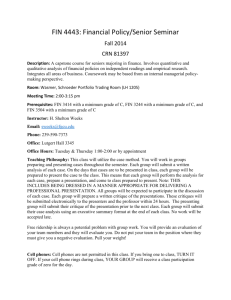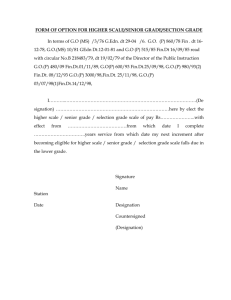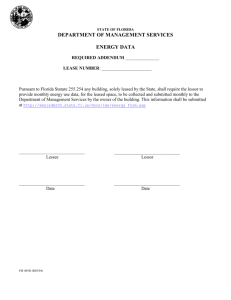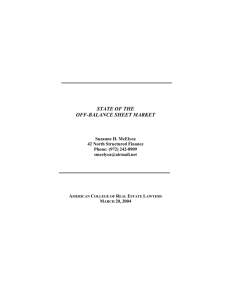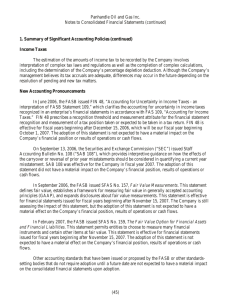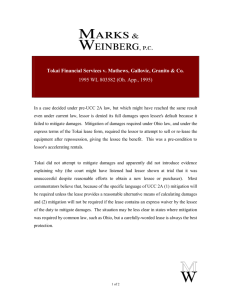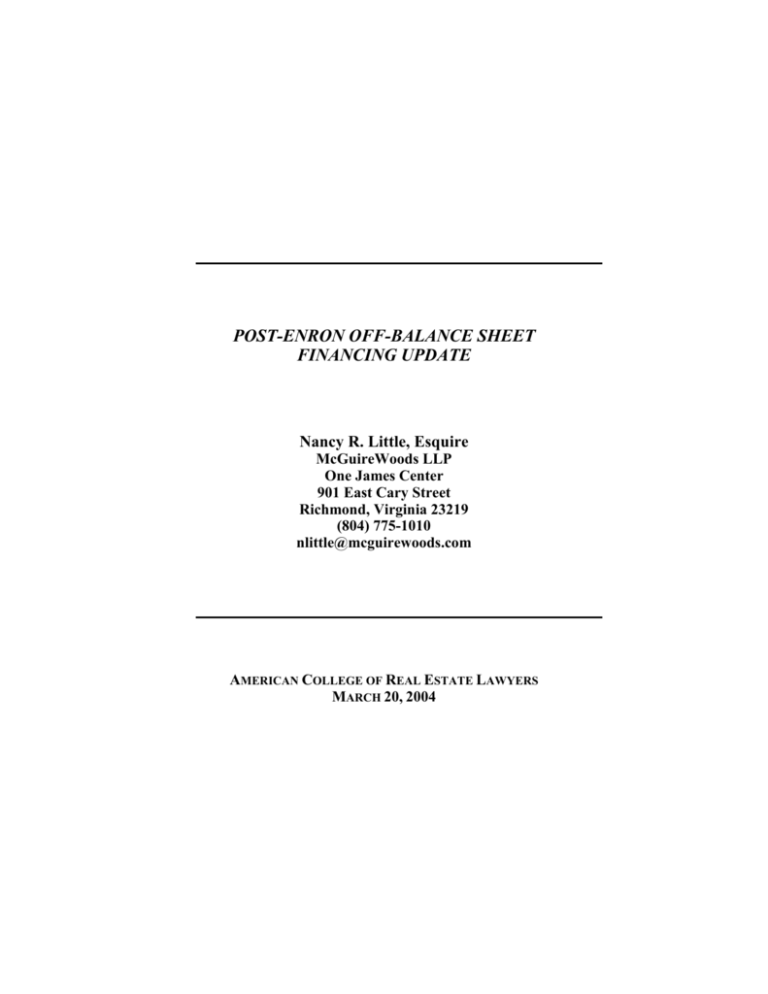
POST-ENRON OFF-BALANCE SHEET
FINANCING UPDATE
Nancy R. Little, Esquire
McGuireWoods LLP
One James Center
901 East Cary Street
Richmond, Virginia 23219
(804) 775-1010
nlittle@mcguirewoods.com
AMERICAN COLLEGE OF REAL ESTATE LAWYERS
MARCH 20, 2004
TABLE OF CONTENTS
Page
I.
INTRODUCTION............................................................................................................ 1
II.
ACCOUNTING RULES ................................................................................................. 1
A.
B.
III.
Basic Off-Balance Sheet Accounting Rules ....................................................... 1
1.
SFAS 13 ..................................................................................................... 1
2.
SFAS 98 ..................................................................................................... 2
3.
Issue No. 90-15 .......................................................................................... 2
4.
Issue No. 96-21 .......................................................................................... 3
5.
Issue No. 97-1 ............................................................................................ 3
6.
Issue No. 97-10 .......................................................................................... 3
7.
Consolidation Policy .................................................................................. 4
8.
Issue No. 00-13 .......................................................................................... 4
Structure of Lessor; Accounting Issues ............................................................. 4
1.
Bankruptcy-Remote Structures .................................................................. 4
2.
Accounting Issues ...................................................................................... 5
POST-ENRON ACCOUNTING RULE CHANGES .................................................... 5
A.
B.
FASB Interpretation No. 46: Consolidation of Variable Interest
Entities .................................................................................................................. 5
1.
Background ................................................................................................ 5
2.
Overview .................................................................................................... 5
3.
Application of FIN 46 ................................................................................ 7
4.
Implementation for Certain Transactions .................................................. 9
5.
Additional FASB Guidance ....................................................................... 9
FASB Interpretation No. 45: Guarantor’s Accounting and Disclosure
Requirements for Guarantees, including Indirect Guarantees of
Indebtedness of Others ...................................................................................... 10
1.
Background .............................................................................................. 10
2.
Application ............................................................................................... 10
3.
Exceptions ................................................................................................ 11
4.
Recognition .............................................................................................. 11
5.
Disclosure ................................................................................................ 12
6.
Effective Date .......................................................................................... 12
-i-
POST-ENRON OFF-BALANCE SHEET FINANCING UPDATE
By Nancy R. Little
© Copyright 2004. All rights reserved.
I.
INTRODUCTION.
Historically, "off-balance sheet" financings have been a popular way to finance corporate
acquisitions and expansion. Synthetic leases, sale-leasebacks and leveraged leases are
examples of off-balance sheet financings that have been widely used to finance a variety
of assets, including retail, office, manufacturing and distribution facilities and power
plants, as well as personal property and equipment such as aircraft. In the wake of
Enron’s bankruptcy, off-balance sheet vehicles, such as synthetic leases and other lease
financing structures, have been the subject of much debate, even those that are
distinguishable from the structures reportedly abused by Enron. This increased attention
has resulted in changes in the accounting rules applicable to these transactions and has
affected their structure.
This outline provides an overview of the primary accounting rules involved in offbalance sheet financings. Included is a summary of certain changes in accounting rules
that affect these transactions.
II.
ACCOUNTING RULES.
A.
Basic Off-Balance Sheet Accounting Rules.
In many off-balance sheet transactions and most lease financings, the parties must
comply with certain accounting rules promulgated by the Financial Accounting Standards
Board (the "FASB"). A brief summary of some of the principal rules follows.
1.
SFAS 13.
Statement of Financial Accounting Standards ("SFAS") No. 13 requires
that all of the following requirements must be met for the lessee to receive
off-balance sheet accounting treatment:
(a)
There can be no automatic transfer of title to the lessee at the end
of the lease term.
(b)
Any option to purchase the property by the lessee cannot be at a
"bargain" purchase price.
(c)
The term of the lease cannot be seventy-five percent or more of the
economic useful life of the leased property.
(d)
2.
3.
The present value of the minimum rental payments cannot be
ninety percent or more of the fair market value of the property,
determined as of the date of the inception of the lease.
SFAS 98.
In order to obtain the principal benefits of a synthetic lease, a transaction
involving real estate should be structured taking into account SFAS No.
98, which applies to sale-leaseback transactions involving real property.
Under SFAS No. 98, a lessee that owns real property, sells it to the lessor
and leases it back cannot have any "continuing involvement" after entering
into the lease other than in a "normal" leaseback arrangement. SFAS No.
98 cites the following as examples of continuing involvement that would
be prohibited:
(a)
An option or obligation to purchase the property by the lessee.
(b)
A guarantee by the lessee of the lessor’s investment or return on
investment.
(c)
Sharing of appreciation in the property with the lessor.
Issue No. 90-15.
The Emerging Issues Task Force ("EITF") of FASB addressed
circumstances under which the lessor and the lessee are "consolidated" for
financial accounting purposes in Impact of Nonsubstantive Lessors,
Residual Value Guarantees, and Other Provisions in Leasing
Transactions, EITF Abstracts (Emerging Issues Task Force of the
Financing Accounting Standards Board), at 623 (1990) ("Issue No. 9015"). Issue No. 90-15 established certain tests that must be met for the
lessee to receive off-balance sheet accounting.
One test in Issue No. 90-15 requires that the lessor’s equity investment
must be "at risk" throughout the entire lease term. Issue No. 90-15 also
limited the use of letters of credit and guarantees as security for the equity
contribution. However, the FASB’s recent accounting rule changes,
which are described below, supersede provisions of Issue No. 90-15. For
example, Issue No. 90-15 suggested three percent as the minimum equity
that qualifies as a "substantive" investment for the purposes of the third
test, and current guidance can result in a requirement of an equity
investment of ten percent or more.
2
4.
Issue No. 96-21.
Issue No. 96-21, among other things, limits the use of non-recourse debt
by a lessor to fund its minimum equity contribution. It also provides that
structuring fees paid by the lessee to the owners of the lessor must be
taken into account for the purposes of applying the ninety percent test
under SFAS No. 13.
5.
Issue No. 97-1.
Issue No. 97-1 limits the circumstances in which the lessee can indemnify
the lessor for pre-existing environmental conditions. If the risk of loss is
not remote, such indemnifications could cause the transaction to be treated
as a sale-leaseback under SFAS No. 98. In addition, Issue No. 97-1
describes the circumstances in which the lease arrangement can include
defaults that are not related to the lessee’s use of the property, such as
defaults based on financial performance. Such defaults, among other
things, must be customary in financing arrangements, and there must be
no indication at the commencement of the lease that a default will occur.
6.
Issue No. 97-10.
Issue No. 97-10 provides that a lessee that bears substantially all of the
construction period risks will be treated as the owner of the assets during
the construction period. Under these circumstances, the provisions of
SFAS No. 98 would apply so that the transaction is treated as a saleleaseback upon completion of construction. Issue No. 97-10 applies a test
similar to the ninety percent "recovery of investment" test of SFAS No. 13
and includes in the lessee’s "maximum guarantee" any amounts that the
lessee is or can be required to make during construction. Such amounts
include, for example, construction amounts guaranteed by the lessee,
equity investments in or loans to the lessor, any obligation to purchase the
project or to fund cost overruns, rent paid during the construction period
and indemnities or guarantees to the lessor.
Certain of these
circumstances may result in the lessee being treated as the owner of the
lessee even if the ninety percent test is met. Issue No. 97-10 has had a
substantial impact on the structuring of synthetic leases because it limits
the lessee’s ability to indemnify the lessor and lender for certain
construction period risks. Accordingly, lenders usually request additional
protections in construction projects, such as assurance of an adequate
contingency in the project budget to cover potential cost overruns.
3
7.
Consolidation Policy.
Several years ago, FASB proposed changes in its consolidation policies
and procedures that could result in the "consolidation" of the lessor with
the lessee for financial accounting purposes if the lessor is an entity
controlled by the lessee. (See Exposure Draft, Proposed Statement of
Financial Accounting Standards No. 154-D, Consolidated Financial
Statements: Policy and Procedures, October 16, 1995.) On February 23,
1999, FASB issued a revised exposure draft that proposed a definition of
control as "the ability of an entity to direct the policies and management
that guide the ongoing activities of another entity so as to increase its
benefits and limit its losses from that other entity’s activities" and provides
that control "involves decision-making ability that is not shared with
others." (See Exposure Draft (Revised), Proposed Statement of Financial
Accounting Standards No. 194-B, Consolidated Financial Statements:
Purpose and Policy, February 23, 1999, Revision of Exposure Draft
issued October 16, 1995.) This consolidation exposure draft was not
adopted by the FASB. Following the collapse of Enron, however, the
FASB renewed its examination of its consolidation policy, which resulted
in FASB Interpretation No. 46 ("FIN 46"), described below.
8.
Issue No. 00-13.
SFAS No. 98 applies to "property improvements" and "integral
equipment," which SFAS No. 98 refers to as "any physical structure or
equipment attached to the real estate, or other parts thereof, that cannot be
removed and used separately without incurring significant cost".
Therefore, integral equipment that is owned by the lessee before
commencement of the lease will result in sale-leaseback treatment. The
EITF responded to the need for clarification on whether equipment is
integral in Issue No. 00-13, which provides that equipment is "integral
equipment" if, as of the commencement of the lease, the removal costs of
the equipment plus any decrease in value exceeds ten percent of the fair
value of the equipment, as installed.
B.
Structure of Lessor; Accounting Issues.
1.
Bankruptcy-Remote Structures.
Historically, the preferred structure for the lessor in off-balance sheet lease
financings has been a special purpose entity ("SPE"). Most lessees and
lenders prefer that the SPE/lessor be structured as a bankruptcy-remote
entity. In addition, the use of SPEs often can facilitate the transfer of
interests in the lessor entity and sometimes enables the parties to avoid
costly transfer taxes. An SPE can help insulate the lessor's investors from
4
liabilities for risks such as environmental contamination. Limited liability
companies, trusts and limited partnerships are examples of SPE structures
that frequently have been used as the lessor in off-balance sheet leasing
transactions.
2.
III.
Accounting Issues.
The entity acting as the lessor must be carefully structured to comply with
current accounting rules. Post-Enron, SPEs have come under intense
scrutiny and, under FIN 46, an SPE that is created solely to own an asset
and lease it to the lessee can be "consolidated" with the lessee for
accounting purposes if the lessee is the "primary beneficiary" of the lease
arrangement. Generally, the lessor must be a "voting interest entity", that
does not have the characteristics of the SPEs formerly used in off-balance
sheet lease transactions or the transaction must otherwise comply with the
requirements of FIN 46. See the discussion of FIN 46, below, for further
details.
POST-ENRON ACCOUNTING RULE CHANGES.
A.
FASB Interpretation No. 46: Consolidation of Variable Interest
Entities.
1.
Background.
Proposed changes to the FASB’s consolidation policy were discussed by
the FASB for most of 2002 following Enron's bankruptcy filing because of
Enron's use of SPEs, although media attention focused predominantly on
Enron's off-balance sheet partnerships and not on its lease financing
transactions. FIN 46 was originally issued on January 17, 2003 as an
interpretation of Accounting Research Bulletin No. 51, Consolidated
Financial Statements ("ARB 51").
2.
Overview.
(a)
Although FIN 46 was not directed specifically at leasing
transactions or securitizations, it has affected both.
(b)
FIN 46 effectively divides entities into two populations:
(i) Voting Interest Entities:
Entities controlled by voting interests for which consolidation
is based on ARB 51 (e.g., consolidation by a corporate parent
of its wholly-owned subsidiary which the parent controls by
5
virtue of its ownership of all of the stock of the subsidiary).
(ii) Variable Interest Entities ("VIEs"):
Entities not controlled through voting interests or whose
equity investors do not bear "residual economic risks", which
are consolidated by their "primary beneficiaries".
(c)
Some SPEs will be subject to FIN 46 (i.e., VIEs) and some will not
(i.e., voting interest entities subject to consolidation under ARB
51).
(d)
FIN 46 also provides for the following "scope" exceptions:
(i) Not-for-profit entities unless such entities are used to
circumvent FIN 46.
(ii) Employee benefit plans subject to other FASB statements.
(iii) Certain registered investment companies.
(iv) QSPEs and transferors to QSPEs subject to SFAS No. 140.
(v) Certain entities subject to SEC Regulation S-X Rule 603(c)(1).
(vi) Life insurance separate accounts.
(e)
Additional scope exceptions were added in the December 2003
revision of FIN 46 ("Rev. FIN 46"). These include scope
exceptions for:
(i) Certain "businesses", as defined in Rev. FIN 46.
(ii) Enterprises with an interest in a VIE created before December
31, 2003 if the enterprise cannot obtain the necessary
information "after making an exhaustive effort."
(iii) Governmental entities except financing entities used like VIEs
to circumvent FIN 46.
(f)
FIN 46 requires disclosure of "variable interests" in a VIE by the
VIE’s primary beneficiary and by the holders of variable interests
in such VIE even if the holder is not the primary beneficiary.
(g)
The effective dates for application of FIN 46 are:
(i) February 1, 2003 for new VIEs.
(ii) The first fiscal or interim period after June 15, 2003 for
existing VIEs; however, effective October 9, 2003, the FASB
deferred until December 31, 2003 (for a company with a
6
calendar year end) the application of FIN 46 for VIEs created
before February 1, 2003. Rev. FIN 46 includes additional
deferrals for certain VIEs, depending upon whether the
reporting entity is a public company, a "small business issuer"
or a non-public company.
3.
Application of FIN 46.
(a)
FIN 46 applies where control of an entity is by other than its voting
interests (i.e., an entity is a VIE), such as where:
(i) The entity’s equity investors do not have a "controlling
financial interest" in the entity,
or
(ii) The entity does not have "sufficient equity at risk … to
finance its activities without additional subordinated financial
support … ."
(b)
FIN 46 includes the following definitions:
(i) Variable Interest Entity:
An entity subject to consolidation under FIN 46.
(ii) Variable Interests:
The "contractual, ownership, or other pecuniary interests in an
entity that change with changes in the entity’s net asset
value."
(iii) Primary beneficiary:
The entity required to consolidate a VIE under FIN 46.
(c)
FIN 46 refers to FASB Concepts Statement No. 7 for
determination of "expected losses" and "expected residual returns".
Accountants and financial advisors structuring off-balance sheet
transactions have developed models to calculate expected losses.
(d)
An entity is subject to consolidation under FIN 46 if, "by design",
either:
(i) The equity at risk is not sufficient to finance the entity’s
activities "without additional unsubordinated financial
support", i.e., the equity is not greater than the entity’s
expected losses,
or
7
(ii) The equity investors, as a group, lack any of the following
"characteristics of a controlling financial interest":
x. The direct or indirect decision-making ability as to
the entity's activities, determined through voting or
similar rights.
y. The obligation to absorb the entity’s expected losses.
z. The right to receive the expected the residual returns.
(e)
Determination; Re-evaluation.
(i) The initial determination under FIN 46 is to be made on the
date an entity first becomes involved with a VIE by
ownership, contract or other variable interests.
(ii) Consolidation under FIN 46 is to be re-evaluated "whenever
the design of the entity or ownership of interests in the entity
changes", such as if:
x. The governing documents or contractual
arrangements change significantly.
y. The equity is returned and other interests are
exposed to the expected losses.
z. The entity’s additional activities or assets increase its
expected losses.
(f)
Required equity.
(i) For VIEs, the amount of equity is presumed to be insufficient
if it is less than 10%, but this presumption is rebuttable.
(ii) An equity investment exceeding ten percent may be required
under certain circumstances.
(g)
Silos.
If a VIE "walls off", or creates a "silo" for, a group of assets
because such assets are the only source of payment for certain of
the entity’s liabilities, the silo is treated as a separate VIE that is to
be consolidated by its primary beneficiary. Note: Silos can only
exist in VIEs.
(h)
Consolidation.
(i) Under FIN 46: "An enterprise shall consolidate a variable
interest entity if that enterprise has a variable interest (or
combination of variable interests) that will absorb a majority
of the entity’s expected losses if they occur, receive a majority
of the entity’s expected residual returns if they occur, or both."
8
(Note: Emphasis is on expected losses more than on expected
returns.)
(ii) "The enterprise that consolidates a variable interest entity is …
the primary beneficiary." (Note: In determining who is the
primary beneficiary, consideration is to be given to variable
interests held by related parties.)
(i)
Disclosure.
(i) Disclosure is required on all financial statements if
consolidation or disclosure is reasonably possible, including:
x. The nature, purpose, size and activities of the VIE.
y. The maximum exposure to loss form involvement
with the VIE.
(ii) The primary beneficiary is to disclose:
x. The nature, purpose, size and activities of the VIE.
y. The carrying amount and classification of assets
that are collateral for the VIE’s obligations.
z. The lack of recourse if creditors do not have
recourse to the VIE’s general credit.
(iii) The following disclosure is required by any non-primary
beneficiary:
x. The nature of the involvement with the VIE and the
date such involvement began.
y. The nature, purpose, size and activities of the VIE.
z. The maximum exposure to loss from involvement
with the VIE.
(j)
4.
5.
Recognition of existing VIEs (if consolidation occurs) is based on
the carrying amounts, with adjustments made for the cumulative
effects of differences between previous the carrying amount and
the amount newly recognized.
Implementation for Certain Transactions.
(a)
For a synthetic lease, the lessee may be required to consolidate the
SPE/Lessor
(b)
True leases and credit tenant loans (leases) are less likely to be
affected.
Additional FASB Guidance.
9
(a)
On October 31, 2003, the FASB issued an Exposure Draft with
proposed changes to clarify the implementation of FIN 46.
(b)
As noted above, FIN 46 was issued in December, 2003. Rev. FIN
46 adds more scope exceptions, defers the implementation of FIN
46 in certain circumstances, addresses the impact of troubled debt
restructurings on reconsideration of VIEs and revises Appendix B
of FIN 46. The impact of Rev. FIN 46 will likely take some time
to fully evaluate.
B.
FASB Interpretation No. 45: Guarantor’s Accounting and Disclosure
Requirements for Guarantees, including Indirect Guarantees of
Indebtedness of Others.
1.
Background.
(a)
The FASB’s guarantee project ("FIN 45") was originally part of
the consolidation project that produced FIN 46 because guarantees
are common in SPE transactions. However, the guarantee project
was spun off as a separate project early in 2002.
(b)
The stated goal of the FASB was to "improve the transparency of a
guarantor’s financial reporting about the obligations and risks
arising from issuing guarantees" in two respects:
(i) To improve disclosure on the nature and the amount of
guarantees, and
(ii) To clarify the initial recognition of guarantee liabilities and
thereby improve reporting of guarantees issued with and
without a "separately identified premium."
2.
(c)
Under prior accounting guidance (SFAS No. 5), recognition of a
guarantee occurred when payment under the guaranty was
"probable" and "reasonably estimable".
(d)
Under FIN 45, the "remoteness" of payment under the guarantee
does not eliminate the need for disclosure and/or recognition.
Application.
(a)
Under FIN 45, a "guarantee" is an agreement to make payments
based on "changes in an underlying" or because another entity fails
to pay. It also includes an indirect guarantee of the obligations of
another entity.
(b)
FIN 45 applies whether the guarantee is embedded in another
transaction or is paid for separately.
10
3.
(c)
FIN 45 also applies to direct and indirect, as well as contingent,
guarantees.
(d)
Indemnification agreements (e.g., indemnities in business
transactions for adverse judgments and lawsuits) are also included
within its scope.
Exceptions.
(a)
FIN 45 includes exceptions for commercial letters of credit and
loan commitments, which are not considered "financial
guarantees" because they do not provide a guarantee of payment of
an obligation. Certain subordination agreements in securitization
transactions are also not financial guarantees.
(b)
Total "scope-outs" from FIN 45 include:
(i) Residual value guarantees in capital leases.
(ii) Contingent rent.
(iii) Certain insurance/re-insurance contracts.
(c)
Certain guarantees are scoped out of the recognition requirements
but not the disclosure requirements, including:
(i) Performance guarantees of non-financial assets.
(ii) Guarantees between a parent and its subsidiaries or
corporations under common control.
(d)
4.
See FIN 45 for other exceptions.
Recognition.
(a)
Recognition under FIN 45 occurs at the inception of the entity's
liability for the guarantee (i.e., the obligation to stand ready to pay)
even if payment is not probable.
(i) Recognition is required for the premium received or
receivable by the guarantor for its guarantee.
(ii) In estimating the guarantee’s fair value a transaction "with
multiple elements" (e.g., a sale of assets or an operating lease),
an inquiry is to be made as to what premium would be
required for the same guarantee in a "standalone arm’s-length
transaction with an unrelated party."
(iii) Recognition is at the greater of (x) fair value or (y) the amount
required under SFAS 5. Reference is made to Concepts
Statement No. 7 for a present value measurement to determine
"fair value."
11
(b)
There are several options that have been suggested to account for
residual value guarantees under leases, one being a credit for the
guarantee obligation and an off-setting entry (debit) for prepaid
rent.
(c)
FIN 45 applies to lease finance and other financial transactions as
well as to sales, etc. where there are guarantees and indemnities.
These can include, for example:
(i) Residual value guarantees.
(ii) Tax and other indemnities.
5.
Disclosure.
FIN 45 also requires disclosure of the nature of the guarantee, e.g., how it
arose and the events that would result in performance by the guarantor, the
maximum amount of future payments, the current "carrying amount" of
the liability, and any recourse the guarantor has to third parties for
recovery of guaranteed amounts and collateral from which the guarantor
could seek recovery.
6.
Effective Date.
(a)
FIN 45 requires recognition for guarantees issued or modified after
December 31, 2002.
(b)
It is not entirely clear, however, which modifications to a
guarantee would trigger recognition.
12
Nancy R. Little is a partner in the law firm of McGuireWoods LLP. Her lease finance
practice includes synthetic leases, sale-leasebacks, and credit tenant loans of real estate and
equipment, including structured transactions utilizing commercial paper conduits and other
securitized loans. Ms. Little received her B.S. from Virginia Polytechnic Institute and State
University and her J.D. from the University of Virginia School of Law. She is a member of the
Virginia State Bar, the Virginia Bar Association, the National Association of Bond Lawyers, the
National Health Lawyers Association, the International Association of Attorneys and Executives
in Corporate Real Estate, the American College of Real Estate Lawyers, the American College of
Mortgage Attorneys and the American Bar Association’s Continuing Legal Education
Committee in the Section of Real Property, Probate and Trust Law. Ms. Little has lectured and
written extensively on lease financing transactions.
\\RIC4\7714\1010\Seminars\2004\ACREL - Mar 2004\Post-Enron Off-Balance Sheet.doc

